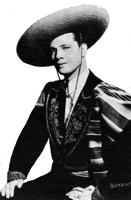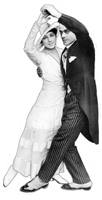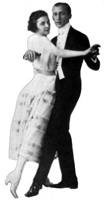
|
The Society of Folk Dance Historians (SFDH)
Argentine Tango
[
Home |
About |
Encyclopedia | CLICK AN IMAGE TO ENLARGE |

|
 Dance historians attribute the sources of the Argentine tango to folk dances from several countries, including Spain, Cuba, and Argentina. Despite this folk heritage, the tango should not be misconstrued as a folk dance; it remains purely a social ballroom dance, popular in so many countries throughout the world it might easily be called the "international dance."
Dance historians attribute the sources of the Argentine tango to folk dances from several countries, including Spain, Cuba, and Argentina. Despite this folk heritage, the tango should not be misconstrued as a folk dance; it remains purely a social ballroom dance, popular in so many countries throughout the world it might easily be called the "international dance."
To trace the development of the ballroom tango, one must untangle some of the factors that have gone into its making. One of the major influences came from Spain, where the Romani or flamenco dances are marked with slow, sustained movements, suddenly contrasted with sharp, staccato steps that may end with a surprising, dramatic halt. In a like manner, the tango from Argentina is marked with the same sharp contrast between slow and quick dance rhythms.
Musically, also, there is a resemblance in construction between the Spanish and Argentine tangos, but there all similarity ends. The Spanish dance is performed by Romani from the Andalusian area. It is usually performed as a slow dance by a woman wearing a man's hat that she manipulates with soft, flowing arm movements while stamping a crisp counter rhythm with her heels. When the dance is given as a couple dance, between man and woman, the partners never assume embraced or ballroom position, nor does the dance cover a large area.
Cuba's contribution to the Argentine tango came from a popular ballroom dance of the 1890 period, called the Habanera. The soft, rocking movements of that dance are still incorporated in many of the contemporary step combinations of the tango.
In the 1800s, a contra dance called the Tangano was a favorite of the gauchos (the cowboys of the vast Argentine plains) and their ladies in Argentina.
All of these dances, and probably many more, found their way into the gradual development of the Argentine ballroom tango. The dance for many years was performed only by the habitues of the waterfront dives of Buenos Aires, and was completely ignored or at least considered with much disfavor by the upper-class Argentinians.

 It was not until about 1913 that the Argentine tango was introduced, after considerable modifications, to the American public. It was first sponsored by such famous exhibition teams as Florence and Maurice Walton and Irene and Vernon Castle. Later, Rudolph Valentino assured a nation-wide viewing of the dance by including it in his screen successes, where he endowed it with a heavy romantic connotation.
It was not until about 1913 that the Argentine tango was introduced, after considerable modifications, to the American public. It was first sponsored by such famous exhibition teams as Florence and Maurice Walton and Irene and Vernon Castle. Later, Rudolph Valentino assured a nation-wide viewing of the dance by including it in his screen successes, where he endowed it with a heavy romantic connotation.
The contemporary tango has undergone further simplification since the time of Valentino, and it is no longer an exhibitionistic dance, but one that can be performed as unobtrusively and simply as a waltz.
It is necessary for the dancer to understand the basic musical structure of the tango. The music is written in a slow 4/4 meter, with two beats (or counts) to the measure. The musical phrasing is divided into four measures of eight counts. While many of the steps of the tango are fitted into this pattern of eight counts, the skillful dancer should be able to combine several dance phrases to avoid a choppy, mechanical pattern of eight counts throughout the dance. At the same time, the dancer must be aware of the overall musical structure so that the dramatic point of the step will coincide with the climax of the dance.
Some so-called tangos, like the popular "Blue Tango," are written in a 2/4 time, and are a Habanera rhythm that does not fit the step patterns or character of the contemporary Argentine tango. Such misnamed tangos should be avoided.
Many step patterns have become traditional in the tango, but even an unexperienced dancer can, with a little imagination, create a very satisfactory dance by making simple variations on the step known as the March. The March is often considered the basic or key step to the tango, and consists of walking in a slow, slow, quick, quick, slow rhythm, to two measures of music, and counted 1, 2, 3&4. The step may then be repeated, but beginning with the other foot, to complete the four additional counts of the musical phrase.
By moving the March sequence forward, backward, and sideward in a circle, or by using closed, open, or promenade position, the step can be made to look different without actually changing the basic placement of the feet.
The hold in the tango should be a flexible one, with the gentleman leading his partner quickly from one position to another, the character of the individual steps dictating whether the clasp is tight or open. The tango is essentially a masculine dance, and must be directed and led by the man, even in a tango with a set sequence of steps.
The most distinguishing feature of the Argentine tango is the method of movement, rather than the exact step patterns. The dancers progress around the floor with a soft, cat-like walk, the legs moving from the hips but keeping the feet close to the floor as they are moved into position. The upper body is held upright, but nonchalantly relaxed, and is brought into position over the standing foot each time a step is taken. There should be no bouncing or syncopation of the knees or body while dancing the tango.
The origin of the dance style goes back to the early days of the dance when ladies wore long, heavily ruffled skirts, and the gauchos wore thick, bulky trousers, and heavy boots fitted with large metal spurs. Their effort to dance in this heavy garb resulted in the characteristic earthy, heavy-light style of movement that should be retained to some extent in the contemporary tango.
Every country has adapted the tango to its own concepts, some of them varying widely from the Argentine version. While the basic step patterns are the same, the method of execution, or style, has most often been changed. This is true of the English tangos, with which most international folk dancers are familiar.
In the English tango, the style is one of lightness, an up-on-the-toes feeling that is especially evident at the end of a phrase where the body is lifted in place of the into-the-earth corte (break) step usually employed in the Argentine dance. English tangos are usually placed in set sequences, with great emphasis being placed on the degree of turn, the exact rise and fall of body placement, etc., in place of the free, ad-libbing steps of the Argentine method. The proficient dancer should be able to accomplish and appreciate both styles of the tango and use each method correctly as the occasion demands.
DOCUMENTS
- Allure of the Tango, an article.
- Argentina, a country,
- Tango Family Tree, an article.
- Waltz, One Step, and Tango Partnering Tips, an article.
Printed in Let's Dance! Magazine, May 1956.
This page © 2018 by Ron Houston.
Please do not copy any part of this page without including this copyright notice.
Please do not copy small portions out of context.
Please do not copy large portions without permission from Ron Houston.